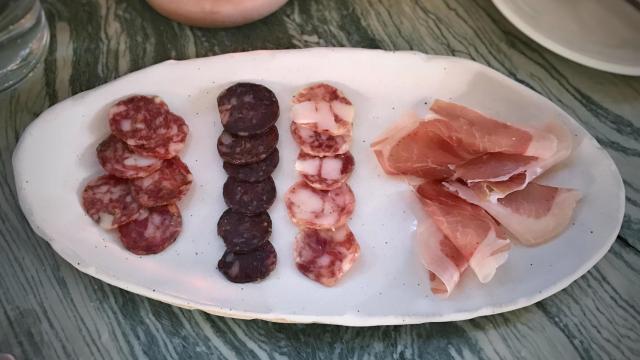Charcuterie is the branch of cooking devoted to prepared meat products, such as bacon, ham, sausage, terrines, galantines, ballotines, pâtés, and confit. If you’ve only heard of half of those terms before, here’s a bogan-friendly meat primer to get you up to speed.
Photo by T.Tseng.
In David Brooks’ most recent op-ed, the New York Times writer tells a little anecdote that brilliantly illustrates just how far most school systems have to go when it comes to charcuterie. Says Brooks:
Recently I took a friend with only a high school degree to lunch. Insensitively, I led her into a gourmet sandwich shop. Suddenly I saw her face freeze up as she was confronted with sandwiches named “Padrino” and “Pomodoro” and ingredients like soppressata, capicollo and a striata baguette. I quickly asked her if she wanted to go somewhere else and she anxiously nodded yes and we ate Mexican.
How embarrassing, right? I mean, she obviously was baulking at the Italian words, and not the prices of the gourmet sandwiches. (Everyone knows you can’t be Italian and poor.) At least he didn’t take her to a French bistro or the IKEA food court, as the KÖTTBULLAR would have been the end of it all.
Also, thank goodness for Mexican food, a cuisine with non-English menu items that are more accessible to those without an advanced degree of some kind. (I’d like to think Brooks ordered a mole dish just so he could give a mini-lecture on how mole is not a culinary monolith.)
Anyway, I wouldn’t want such an unfortunate scenario to befall you, especially if you have a friend that likes to take you to lunch as some sort of classist cultural litmus test, so I’ve put together a little primer for these primo Italian meats:
- Soppressata: Whole classes could be taught on this little salami, as there are many types, both dry-cured and not. I’m partial to Soppressata di Calabria which has a nice, smoky, piquant flavour and a vibrant red colour which is quite different from Soppressata Toscana, an uncured meat made from mostly pig head.
- Capicolla: “Capicolla” is a regional term for “capocollo”, a delicate pork cold cut made from the “dry-cured muscle running from the neck to the 4th or 5th rib of the pork shoulder or neck“. Seasoning varies from region to region, but wine and garlic are usually involved, which is great. The thin, fatty slices are quite delicious eaten in front of an open fridge at three in the morning.
- Striata baguette: This is clearly not a meat, but a bread, but it still made Brooks’ dining companion very anxious, so we’ll talk about it. I had never heard of this one, and believe you me, my face froze right up when I first read those very confusing words. It seems that it “striata” simply means “stretch”, and there has been quite the kerfuffle over who created stretch bread and what exactly it is. I remain vaguely confused.
- Mortadella: This one isn’t mentioned by Brooks, but mortadella is just fancy bologna with cubes of pork fat in it, and I’ll eat on white bread with American cheese if I want to, damn it.
- Prosciutto: This also isn’t in the op-ed, but it’s very important. Prosciutto is a delicious dry-cured ham that can be served uncooked or cooked, but I don’t know why you would cook those paper-thin slices of wonder. (There’s also prosciutto cotto, a fairly low-sodium cooked ham, which is different from the crudo product.) You should probably wrap it around some rockmelon or grilled pineapple.
I hope we’ve filled in some gaps in your meat education and, if you encounter a sandwich in the future that fills you with existential dread, let me know and I’ll do my best to help.

Comments
5 responses to “The Bogan’s Guide To Charcuterie”
my local food land sells Lachsschinken
https://www.german-butchery.com.au/products/air-dried/lachsschinken
i grew up eating this stuff – great tasting.
also dutch smoked beef
jamon serrano is really nice
Leberwurst (Liverwurst) is also tasty, spread it on some rye bread and top with pickles or sweet and sour gherkins.
Really quite an insulting clickbait title.
I really don’t think that the next level down from gourmand is bogan….
Plenty of data showing that processed meats are terrible for your health.
Historically this food was made by peasants for their consumption not the high end of society
Don’t need or want to waste money or have any gaps filled or education in products made from offel.
What is the point of this article when Australia has a wide variety of wholesome, healthy food.